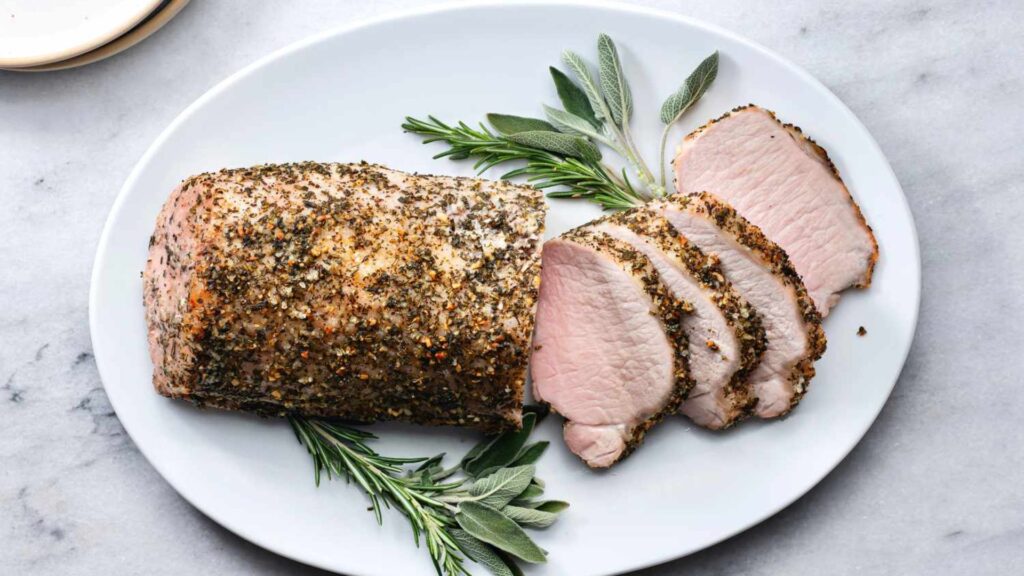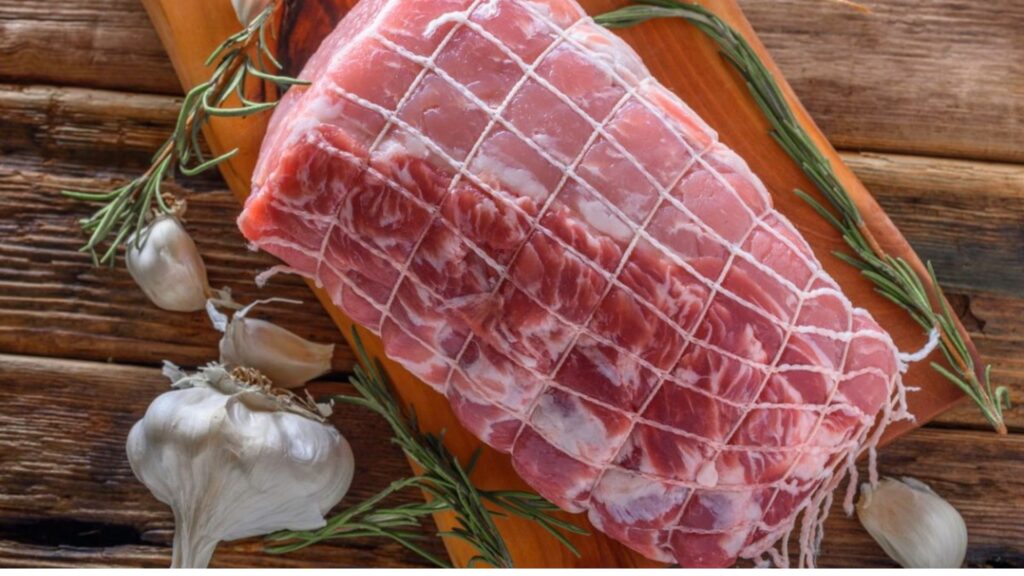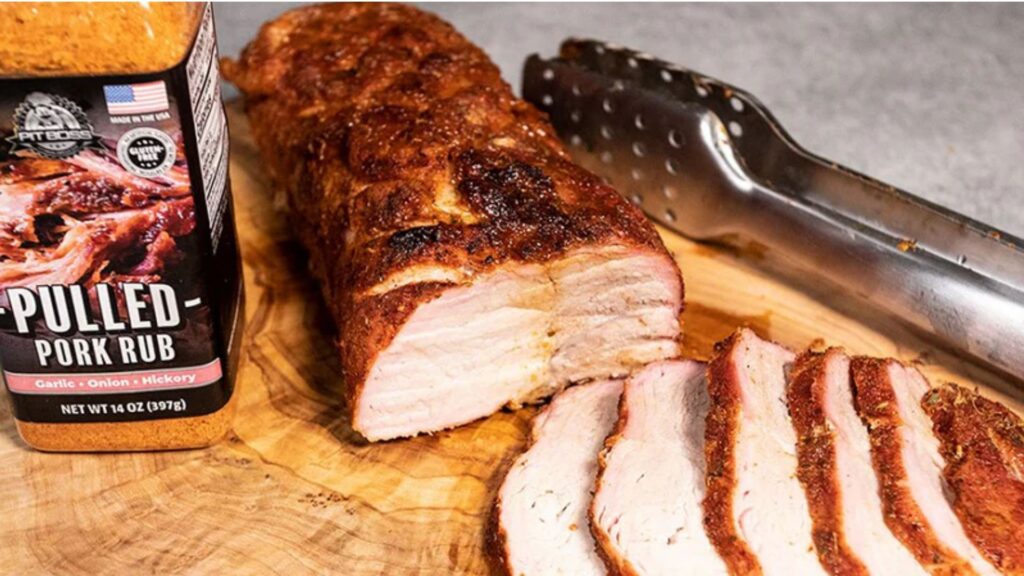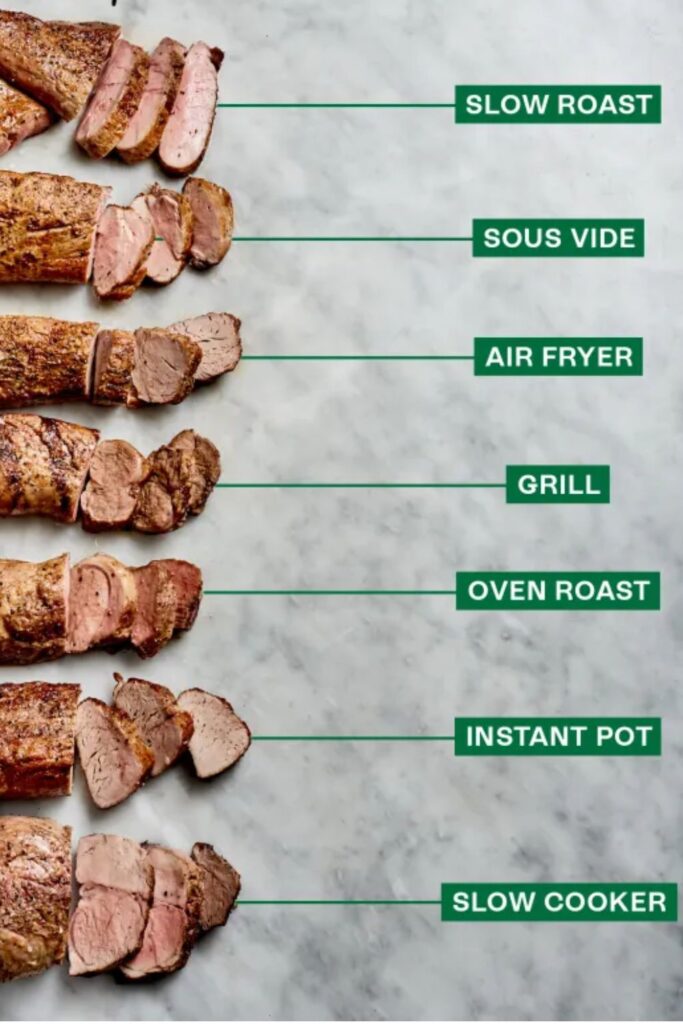
How to Cook Pork Loin: A Delicious and Juicy Recipe
Preparing a perfectly cooked pork loin can elevate any meal and impress your family and friends. This comprehensive guide will walk you through the steps to cook a tender, flavorful pork loin dish that will have everyone coming back for more.
Whether you’re a seasoned home cook or a beginner in the kitchen, you’ll learn how to select the right pork loin cut, season it to perfection, and use various cooking methods to achieve a mouthwatering pork roast or pork tenderloin.
From oven roasting to grilling, we’ve got you covered with everything you need to know to create a delicious juicy pork loin meal.
Key Takeaways
- Understand the differences between pork loin roast and pork tenderloin to choose the right cut for your recipe.
- Learn how to select high-quality, flavorful pork loin from reputable sources.
- Discover the best seasoning blends and kitchen tools to prepare your pork loin for cooking.
- Explore various cooking methods, such as oven roasting, slow cooking, and grilling, to achieve the perfect pork loin.
- Master the art of checking for doneness and resting the pork loin to ensure a juicy, tender result.
Understanding Pork Loin Cuts
Pork loin is a versatile and popular cut that offers a range of options for home cooks. To get the best results, it’s important to understand the differences between a pork loin roast and a pork tenderloin, as well as the advantages of choosing a bone-in or boneless pork loin.
Loin Roast vs. Tenderloin
A pork loin roast is a larger, more muscular cut that is ideal for slow roasting, while a pork tenderloin is a smaller, more tender cut that can be quickly seared or grilled. The loin roast has a richer, more robust flavor, while the tenderloin is delicate and tender. When deciding between the two, consider the cooking method and the number of people you’ll be serving.
Bone-in or Boneless
Another important consideration when selecting a pork loin is whether to choose a bone-in or boneless cut. Bone-in pork loin provides more flavor and moisture, as the bone helps to retain the natural juices. However, a boneless pork loin is easier to slice and portion, making it a convenient choice for smaller households or individual servings.
Choosing the Perfect Pork Loin

When selecting apork loin
for your recipe, it’s crucial to choose a high-quality cut from a reputable source. Look forpork loin
that is pale pink in color, with a firm, fine-grained texture and a thin, uniform layer of fat. This indicates ahigh-quality pork loin
that will cook up tender and flavorful.
Selecting High-Quality Meat
To ensure you’re getting the best pork loin, take the time to inspect the meat carefully. Look for a cut that is free of any blemishes or discoloration, and feels firm and dense to the touch. Avoid pork loin that appears watery or has an overly soft texture, as this can be a sign of poor quality.
Considering Organic or Pasture-Raised Options
If you’re willing to invest a bit more, consider opting for organic or pasture-raised pork loin. These pork loin cuts often have a richer, more robust flavor and may offer additional nutritional benefits compared to conventionally raised pork. The animals are typically allowed to roam freely and are fed a natural, hormone-free diet, resulting in a high-quality pork loin that’s worth the extra cost.
Essential Ingredients and Equipment
To craft a mouthwatering pork loin dish, you’ll need a carefully curated collection of pork loin ingredients and the right pork loin cooking equipment. Start with a well-seasoned pork loin, using a flavorful blend of pork loin seasoning like garlic, rosemary, thyme, and black pepper. Pair this with essential pork loin tools such as a roasting pan, meat thermometer, and a sharp carving knife to ensure your pork loin is cooked to perfection and sliced evenly for serving.
Spices and Herbs for Seasoning
The key to a truly remarkable pork loin lies in the careful selection and combination of spices and herbs. Elevate the natural flavors of the pork loin ingredients by rubbing the roast with a blend of minced garlic, fragrant rosemary, earthy thyme, and freshly ground black pepper. This simple seasoning mix will impart a delightful depth of flavor, creating a crisp, golden-brown crust and juicy, tender interior.
Kitchen Tools Needed

To ensure your pork loin cooking process goes smoothly, make sure you have the right pork loin cooking equipment on hand. A sturdy roasting pan will allow the pork loin ingredients to cook evenly, while a reliable meat thermometer is essential for monitoring the internal temperature and achieving the perfect level of doneness. Finally, a sharp carving knife is a must-have pork loin tool for slicing the tender roast into perfect, even portions for serving.
| Essential Pork Loin Ingredients | Necessary Pork Loin Cooking Equipment | Helpful Pork Loin Tools |
|---|---|---|
| Pork loin roastGarlicRosemaryThymeBlack pepper | Roasting panMeat thermometer | Sharp carving knifeBasting brushButcher’s twine |
Preparing the Pork Loin
Before cooking, it’s essential to properly prepare the pork loin to ensure optimal flavor and texture. Start by carefully trimming any excess fat or silver skin from the surface of the meat. Removing these elements can prevent uneven cooking and create a tough, chewy texture in the final dish.
Next, it’s time to tie the pork loin with butcher’s twine. This step helps the roast maintain its shape and cook evenly throughout. Wrap the twine around the pork loin at 1-inch intervals, gently pulling the meat together as you go to create a uniform, cylindrical shape.
By taking the time to trim and tie the pork loin before cooking, you’ll ensure a juicy, flavorful result that’s sure to impress your family and guests.
How to Cook Pork Loin
Whether you’re roasting, slow cooking, or grilling your pork loin, the key to achieving a perfectly cooked and juicy result lies in the preparation and cooking method. From the recommended temperatures to the ideal cooking times, we’ll guide you through the various techniques to ensure your pork loin turns out mouthwatering every time.

For oven roasting, preheat your oven to 400°F (200°C). Season the pork loin with your desired herbs and spices, then place it in a roasting pan. Roast for 30-40 minutes per pound, or until the internal temperature reaches 145°F (63°C) for a medium-rare doneness. Allow the pork loin to rest for 10-15 minutes before slicing and serving.
Slow cooking is a great option for pork loin when you want a hands-off, tender result. Place the seasoned pork loin in a slow cooker or Instant Pot, add some broth or wine, and cook on low for 6-8 hours or high for 3-4 hours, until the internal temperature reaches 145°F (63°C).
For a smoky, grilled pork loin, preheat your grill to medium-high heat. Sear the pork loin for 2-3 minutes per side to get a nice char, then reduce the heat to medium-low and continue cooking, turning occasionally, until the internal temperature reaches 145°F (63°C), about 20-25 minutes total.
Regardless of the cooking method you choose, be sure to use a reliable meat thermometer to ensure your pork loin is cooked to the perfect doneness. Allow the meat to rest for 10-15 minutes before slicing and serving, which will help the juices redistribute for a moist and flavorful final dish.
Cooking Methods for Juicy Pork Loin
Pork loin can be cooked using a variety of methods, each with its own unique benefits. Whether you prefer the classic oven roasting technique, the convenience of slow cooking, or the smoky flavor of grilling or smoking, there are numerous ways to achieve a perfectly tender and juicy pork loin every time.
Oven Roasting
Oven roasting is a timeless method for cooking oven roasted pork loin. This technique produces a crisp, golden-brown exterior and a juicy, tender interior. By seasoning the pork loin with a blend of herbs and spices and roasting it at a high temperature, you can create a mouthwatering crust while ensuring the center remains succulent and flavorful.
Slow Cooker or Instant Pot
For a hands-off approach, slow cooker pork loin or instant pot pork loin are excellent options. These methods allow the pork loin to slowly tenderize and develop rich, complex flavors as it cooks in the low-and-slow environment of a crockpot or pressure cooker. The result is a fall-off-the-bone tender pork loin that’s perfect for busy weeknights or casual gatherings.
Grilling or Smoking
For a delightful smoky flavor, consider grilled pork loin or smoked pork loin. Grilling the pork loin over direct heat creates a beautiful sear and caramelization, while smoking it infuses the meat with a delicious, deep-rooted smokiness. These techniques add a unique dimension to your pork loin, making it an impressive choice for special occasions or backyard barbecues.
Regardless of the cooking method you choose, the key to achieving a juicy and flavorful pork loin is to pay close attention to the temperature and timing. Follow the specific instructions for each technique, and use a reliable meat thermometer to ensure your pork loin reaches the perfect level of doneness. With a little practice, you’ll be able to master any of these cooking methods and consistently produce delicious pork loin dishes that will impress your family and friends.
Learn More Recipe: How to Cook Salmon in a Pan
Checking for Doneness
Properly checking the pork loin doneness is crucial to ensuring a juicy, flavorful result. Using a reliable meat thermometer is the best way to accurately monitor the pork loin internal temperature as it cooks. By understanding the ideal pork loin cooking temperature for different levels of doneness, you can achieve your desired level of tenderness.
Using a Meat Thermometer
Inserting a digital meat thermometer into the thickest part of the pork loin, away from any bones or fat, is the most accurate way to check the internal temperature. This will provide you with a precise reading, allowing you to remove the pork from the heat source at the perfect moment.
Temperature Guidelines for Different Doneness Levels
Here are the recommended pork loin internal temperature ranges for various levels of doneness:
| Doneness Level | Internal Temperature (°F) |
|---|---|
| Medium-Rare | 145°F |
| Medium | 150°F |
| Medium-Well | 155°F |
| Well-Done | 160°F |
Remember, the internal temperature of the pork loin will continue to rise by a few degrees even after it’s been removed from the heat source, so it’s best to take it out a bit earlier than your desired doneness level. Allow the pork to rest for a few minutes before slicing and serving for the juiciest, most flavorful results.
Resting and Slicing the Pork Loin
After your pork loin has finished cooking, it’s essential to allow it to rest for several minutes before slicing and serving. This resting period is crucial, as it allows the juices to redistribute throughout the meat, resulting in a moist and flavorful final dish. The recommended resting time for a pork loin is typically 10-15 minutes, during which time the internal temperature will continue to rise slightly.
When the pork loin has rested, use a sharp carving knife to slice it into even, thin pieces. This will reveal the juicy, tender interior of the meat, showcasing the delicious results of your efforts. Be sure to slice against the grain of the meat, which will help to ensure a tender, easy-to-chew texture. Serve the pork loin immediately, garnished with your choice of fresh herbs or a flavorful sauce, and enjoy the mouthwatering reward of your perfectly cooked pork loin.
Resting the pork loin and slicing it properly are the final steps in ensuring a delicious and juicy final dish. By following these simple tips, you can elevate your pork loin recipe to new heights and impress your family and friends with your culinary skills.
Learn More Recipe: How To Cook London Broil
FAQ
What is the difference between a pork loin roast and a pork tenderloin?
Pork loin roast is a larger, more muscular cut that is ideal for slow roasting, while pork tenderloin is a smaller, more tender cut that can be quickly seared or grilled.
Should I choose a bone-in or boneless pork loin?
Bone-in pork loin provides more flavor and moisture, while boneless is easier to slice and portion.
What should I look for when selecting a high-quality pork loin?
Look for pork loin that is pale pink in color, with a firm, fine-grained texture and a thin, uniform layer of fat. Consider opting for organic or pasture-raised pork for a richer flavor and more nutritional benefits.
What seasonings and herbs work well with pork loin?
Garlic, rosemary, thyme, and black pepper are all excellent choices for seasoning pork loin.
How do I properly prepare the pork loin before cooking?
Begin by trimming any excess fat or silver skin from the surface of the meat, then tie the pork loin with butcher’s twine to help it maintain its shape and cook evenly.
What are the best cooking methods for pork loin?
Pork loin can be cooked using a variety of methods, including oven roasting, slow cooking in a crockpot or Instant Pot, and grilling or smoking.
How do I know when my pork loin is cooked to the right doneness?
Use a reliable meat thermometer to monitor the internal temperature of the pork loin. The ideal temperature range for medium doneness is 145-150°F.
How long should I let the pork loin rest before slicing and serving?
Allow the pork loin to rest for 5-10 minutes before slicing to allow the juices to redistribute throughout the meat.
Learn More Recipe: How To Cook Flank Steak
[…] Learn More Recipe: How to Cook Pork Loin […]
[…] Learn More Recipe: How to Cook Pork Loin […]